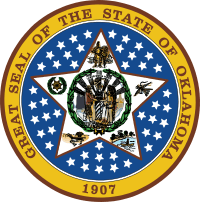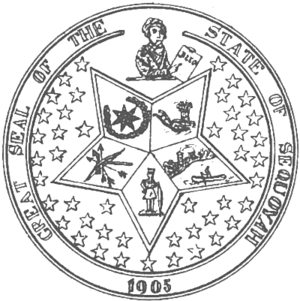Seal of Oklahoma facts for kids
Quick facts for kids Great Seal of the State of Oklahoma |
|
|---|---|
 |
|
| Armiger | State of Oklahoma |
| Adopted | 1905 |
| Motto | Labor Omnia Vincit |
 |
The Great Seal of the State of Oklahoma is a special symbol. It looks like a five-pointed star inside a circle. This seal is very important for the state.
The flag of the governor of Oklahoma also uses this seal. It is a forest green flag with gold edges. In the middle, it has the state seal. Around the seal, there are five white stars in a circle.
Contents
What's Inside the Great Seal?
The Great Seal of Oklahoma has six smaller seals within it. Each part tells a story about Oklahoma's history and people.
The Center Seal: Oklahoma Territory
The very middle of the large star holds the seal of the original Oklahoma Territory. This was the name of the area before it became a state.
- The words Labor Omnia Vincit are on this seal. This means 'Labor Conquers All Things'.
- A woman named Columbia is in the center. She stands for fairness and Oklahoma becoming a state.
- On her right is an American pioneer farmer. On her left is a Native American.
- They are shaking hands under the scales of Justice. This shows that everyone, both Anglo and Native American people, should be treated fairly in Oklahoma.
- Below them, you can see a cornucopia (a horn of plenty) and an olive branch. These stand for good harvests and peace.
- Behind them, the sun shines. It represents progress and new beginnings.
The Five Civilized Tribes Seals
The five points of the large star hold the seals of the Five Civilized Tribes. These tribes – the Cherokee, Chickasaw, Choctaw, Creek, and Seminole – have a big presence in Oklahoma.
Cherokee Nation Seal
The seal of the Cherokee Nation is in the top left point of the star.
- It has a large, seven-pointed star. This star represents the seven old clans of the Cherokee people.
- A wreath of oak leaves surrounds the star. Oak wood was very important in the old Cherokee lands.
- It was used to keep their sacred fire burning forever. Oak also symbolizes strength and long life.
Chickasaw Nation Seal
The seal of the Chickasaw Nation is in the top point of the star.
- It shows an Indian warrior in old clothing.
- He holds two arrows in his right hand and a long bow in his left.
- He has a shield on his left shoulder.
- The two arrows show his protection over the two old tribal groups.
- The bow and shield are symbols of the Chickasaw warrior.
Choctaw Nation Seal
The seal of the Choctaw Nation is in the top right point of the star.
- It shows a bow that is not strung. It also has three arrows.
- A pipe and a hatchet are blended together.
- The pipe-hatchet was smoked in meetings when important decisions were made.
- The Choctaws were peaceful people, but also strong defenders of their homes.
- The unstrung bow means peace, but also being ready to defend themselves.
- The three arrows were always ready and stood for the three great Choctaw chiefs.
Creek Nation Seal
The seal of the Creek (Muscogee) Nation is in the lower left point of the star.
- It shows a sheaf of wheat and a plow.
- The plow and wheat show their farming skills. The Creeks were known for farming a long time ago.
- These symbols represent the good things that farming brought to the Creek people.
Seminole Nation Seal
The seal of the Seminole Nation is in the lower right point of the star.
- It shows a tribesman with feathers paddling a canoe.
- He is crossing a lake to a village with a trading post.
- This scene shows old customs like gathering and trading sacred plants.
- It is a symbol of peace and plenty.
The Smaller Stars
Around the large star, there are 45 smaller stars. These stars represent the 45 U.S. states that existed before Oklahoma became a state. The large star in the middle is like the 46th star. It represents Oklahoma joining the United States as the 46th state.
The State of Sequoyah

The Great Seal was first chosen in 1905. This was for a planned state called state of Sequoyah. This proposed state was named after Sequoyah, who created the Cherokee syllabary (a writing system). The idea was for Indian Territory (the eastern part of what is now Oklahoma) to become its own state.
See also
 In Spanish: Gran sello del estado de Oklahoma para niños
In Spanish: Gran sello del estado de Oklahoma para niños

